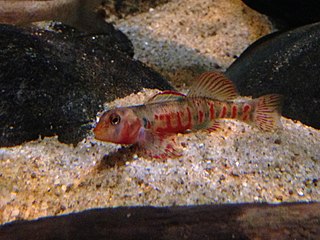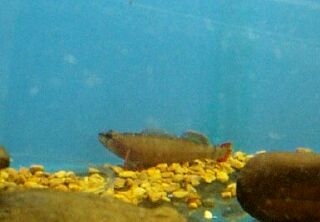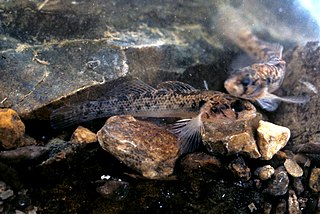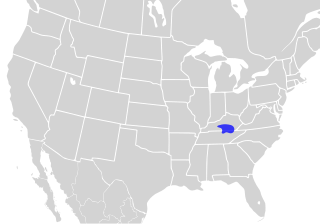
The watercress darter is a species of freshwater ray-finned fish, a darter from the subfamily Etheostomatinae, part of the family Percidae, which also contains the perches, ruffes and pikeperches. It is endemic to the eastern United States where it is only known from the Black Warrior River drainage basin near Birmingham, Alabama.

The Kanawha darter is a species of freshwater ray-finned fish, a darter from the subfamily Etheostomatinae, part of the family Percidae, which also contains the perches, ruffes and pikeperches. It is endemic to the southeastern United States.
The redband darter is a species of freshwater ray-finned fish, a darter from the subfamily Etheostomatinae, part of the family Percidae, which also contains the perches, ruffes and pikeperches. It is endemic to the state of Tennessee in the eastern United States.

The spotted darter is a species of freshwater ray-finned fish, a darter from the subfamily Etheostomatinae, part of the family Percidae, which also contains the perches, ruffes and pikeperches. It is endemic to the eastern United States where it occurs in the basin of the Ohio River. It inhabits fast-flowing rocky riffles of medium-sized and smaller rivers. This species can reach a length of 9 centimetres (3.5 in) TL though most only reach about 5.5 centimetres (2.2 in).
The pinewoods darter is a species of freshwater ray-finned fish, a darter from the subfamily Etheostomatinae, part of the family Percidae, which also contains the perches, ruffes and pikeperches. It is endemic to the eastern United States where it is only known to occur in the Little Peedee River system in the Carolinas. It inhabits creeks, preferring gravel riffles and vegetated areas with strong currents. This species can reach a length of 7.6 centimetres (3.0 in) TL though most only reach about 5.2 centimetres (2.0 in).

The yellowcheek darter is a species of freshwater ray-finned fish, a darter from the subfamily Etheostomatinae, part of the family Percidae, which also contains the perches, ruffes and pikeperches. It is endemic to the eastern United States where it is only known to occur in the state of Arkansas in the Little Red River. It inhabits medium-sized and smaller rivers in rocky riffles with strong current. This species can reach a length of 7.2 centimetres (2.8 in) TL though most only reach about 4.9 centimetres (1.9 in).
The paleback darter is a species of freshwater ray-finned fish, a darter from the subfamily Etheostomatinae, part of the family Percidae, which also contains the perches, ruffes and pikeperches. It is endemic to Arkansas, United States. It is only known to occur in the Caddo River and in Hallmans Creek, a tributary of the Ouachita River. This species inhabits headwaters and creeks where it lives in rocky, shallow pools and also in springs with plentiful vegetation growth. This species can reach a length of 6 centimetres (2.4 in) TL though most only reach about 3.9 centimetres (1.5 in).
The Bayou darter is a rare species of freshwater ray-finned fish, a darter from the subfamily Etheostomatinae, part of the family Percidae, which also contains the perches, ruffes and pikeperches. It is endemic to western Mississippi in the United States, where it is found only in the Bayou Pierre River and its tributaries. Its typical habitat is fast-flowing creeks and streams, in riffles and in areas between riffles with firm gravel bottoms. It feeds on small insects and their larvae. Breeding probably takes place twice a year, in spring and late summer. The population of this fish is declining due to loss of suitable habitat. This is caused by siltation and pollution, particularly erosion caused by changes in land use. The International Union for Conservation of Nature has assessed its conservation status as being "endangered".

The striated darter is a species of freshwater ray-finned fish, a darter from the subfamily Etheostomatinae, part of the family Percidae, which also contains the perches, ruffes and pikeperches. It is endemic to the eastern United States. It occurs in the Duck River system in Tennessee. It inhabits rocky pools in creeks. This species can reach a length of 5.6 centimetres (2.2 in) TL though most only reach about 3.8 centimetres (1.5 in).
The Tuscumbia darter is a species of freshwater ray-finned fish, a darter from the subfamily Etheostomatinae, part of the family Percidae, which also contains the perches, ruffes and pikeperches. It is endemic to the southeastern United States where it occurs in well-vegetated springs along the Tennessee River in Alabama. This species can reach a length of 6.1 centimetres (2.4 in) TL though most only reach about 4 centimetres (1.6 in).

The Highland Rim darter is a species of freshwater ray-finned fish, a darter from the subfamily Etheostomatinae, part of the family Percidae, which also contains the perches, ruffes and pikeperches. It is endemic to the eastern United States, where it is only known to occur in Tennessee and Kentucky in the Barren River system. This species can reach a length of 5.6 centimetres (2.2 in) SL.

The headwater darter is a species of freshwater ray-finned fish, a darter from the subfamily Etheostomatinae, part of the family Percidae, which also contains the perches, ruffes and pikeperches. It is endemic to the eastern United States where it is found in Kentucky and Tennessee in the upper Green River system down to the Mud River, in the Cumberland River and upper Salt River systems. It is an inhabitant of streams up to about 5 metres (16 ft) wide with gravel or cobble substrates. Males of this species can reach a length of 6.2 centimetres (2.4 in) SL while females only reach 5.7 centimetres (2.2 in). The headwater darter was first formally described in 2002 by Patrick A. Ceas and Brooks M. Burr With the type locality given as Koger Creek, which is in the drainage of the Wolf River, about 0.8 kilometers northwest of Rolan, Kentucky along Kentucky Route 415 at the confluence of McIver Creek in Clinton County. The specific name honors the American ichthyologist Lawrence M. Page of the Florida Museum of Natural History.
Nothonotus microlepidum, the smallscale darter, is a species of freshwater ray-finned fish, a darter from the subfamily Etheostomatinae, part of the family Percidae, which also contains the perches, ruffes and pikeperches. It is endemic to the southeastern United States. It occurs in the lower Cumberland River drainage in the states of Kentucky and Tennessee. It inhabits shallow riffles with gravel substrates in small rivers. Breeding habits of the smallscale darter are typical of the E. maculatum group in that females deposit large masses of eggs on the undersides of rocks to be protected by the males. This species is a fairly large, deep-bodied fish with dark background coloration mixed with bright red spots scattered alongside the body. Nuptial males of this species also have deep green fins with orange margins on the spinous dorsal and caudal fins, with the soft dorsal fins having a dark coloration moving marginally to yellow-orangish center with black margins. This species can reach a length of 7.2 centimetres (2.8 in) TL though most only reach about 4.8 centimetres (1.9 in).
The blackfin darter is a species of freshwater ray-finned fish, a darter from the subfamily Etheostomatinae, part of the family Percidae, which also contains the perches, ruffes and pikeperches. It is endemic to the eastern United States where it occurs in the Tennessee River drainage, being found from the Paint Rock River to the Duck River system. It is an inhabitant of small rivers and creeks, living in small pools and nearby riffles. This species can reach a length of 8.8 centimetres (3.5 in) TL.
The sooty darter is a species of freshwater ray-finned fish, a darter from the subfamily Etheostomatinae, part of the family Percidae, which also contains the perches, ruffes and pikeperches. It is endemic the eastern United States. It is found in the Cumberland River basin where it is found only in the lower portion of the Caney Fork system and nearby tributaries in central Tennessee. It inhabits streams and creeks occurring in pools and their nearby riffles. This species can reach a length of 8 centimetres (3.1 in) TL though most only reach about 5 centimetres (2.0 in).
The firebelly darter is a species of freshwater ray-finned fish, a darter from the subfamily Etheostomatinae, part of the family Percidae, which also contains the perches, ruffes and pikeperches. It is endemic to the eastern United States, where it is only known to occur in the drainage systems of the Obion and Forked Deer rivers of Kentucky and Tennessee. It inhabits gravel or sand-bottomed pools in creeks up to small rivers. This species can reach a length of 7 centimetres (2.8 in) TL.
The rock darter is a species of freshwater ray-finned fish, a darter from the subfamily Etheostomatinae, part of the family Percidae, which also contains the perches, ruffes and pikeperches. It is endemic to the southeastern United States where it is found only in Mobile Bay drainage. It is an inhabitant of swiftly flowing riffles of creeks to medium-sized rivers. This species can reach a length of 8.3 centimetres (3.3 in) TL though most only reach about 6 centimetres (2.4 in).
The slabrock darter is a species of freshwater ray-finned fish, a darter from the subfamily Etheostomatinae, part of the family Percidae, which also contains the perches, ruffes and pikeperches. It is endemic to the eastern United States. It occurs in the drainages of the lower Cumberland River and the lower Tennessee River in the states of Kentucky and Tennessee. It inhabits rocky pools in smaller rivers and streams, and along the rocky margins of larger streams and bodies of water. This species preys on insect larvae and extremely small crustaceans. It can reach a length of 6.2 centimetres (2.4 in) TL though most only reach about 4.1 centimetres (1.6 in). The specific name honors the vertebrate zoologist, Dr. Philip Wayne Smith (1921-1986).
The spottail darter is a species of freshwater ray-finned fish, a darter from the subfamily Etheostomatinae, part of the family Percidae, which also contains the perches, ruffes and pikeperches. It is endemic to the eastern United States. It is found in the Ohio River basin and in the Red River system of the Cumberland River drainage. It inhabits rocky pools and nearby riffles of flowing waters up to the size of small rivers.
The bandfin darter is a species of freshwater ray-finned fish, a darter from the subfamily Etheostomatinae, part of the family Percidae, which also contains the perches, ruffes and pikeperches. It is endemic to the eastern United States. It occurs in tributaries of the lower Tennessee River system and uppermost Black Warrior River system. This species inhabits gravel and sandy pools in flowing waters up to the size of small rivers. It can reach a length of 7.1 centimetres (2.8 in) TL.







